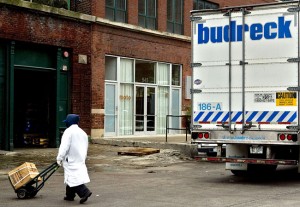“We’ve got 100-year-old businesses selling wholesale pork rinds and bulk-size canned tomatoes next to world-class galleries selling $50,000 paintings.”
Stand on West Fulton Market in Chicago at around 3 p.m. and witness an incongruous changeover. Forklifts hauling greasy pallets of sliced bacon clear out, as bright young things in stiletto heels and luxury cars roll in.
This is Chicago’s meatpacking district, just west of the Loop and known as the West Loop. And like its sister in New York City, the gritty, blood-soaked and sometimes rancid-smelling neighborhood is undergoing a major transformation.
“We’ve got 100-year-old businesses selling wholesale pork rinds and bulk-size canned tomatoes next to world-class galleries selling $50,000 paintings,” said Eric Sedler, president of the West Loop community organization. “That’s what makes this neighborhood so appealing — it’s not overly planned or fabricated. It’s been growing in this organic, evolutionary way for 12, 15 years now.”
The latest wave started along West Randolph Street, an industrial strip where trend-setting restaurants like Blackbird and Marché opened. But now it’s pushing north, to the 19th-century warehouses, cold meat lockers and loading docks along West Fulton Market and West Lake Street.
Among the pioneers is the Fulton Lounge (955 West Fulton Market, 312-942-9500, www.fultonlounge.com ), a sophisticated bar and lounge with 15-foot ceilings, exposed brick walls and shag rugs. What was once a desolate street corner now bustles with parking valets and stylish young people in big sunglasses.
A few doors down is Moto restaurant (945 West Fulton Market, 312-491-0058, www.motorestaurant.com), where the mad scientist-chef Homaro Cantu, a Charlie Trotter protégé, creates “postmodern” food using liquid nitrogen, carbon dioxide and lasers. The chili cheese nachos, for example, taste like a fruit salad, and the menu is printed on edible, panini-flavored paper (five-course tasting menu, $70).
On Lake Street, boutiques and galleries are sprouting under the elevated train tracks that stripe the asphalt with shadows. Every few minutes, a train thunders past, but the fashionable newcomers don’t seem to mind, not with the cheap rents.
“For what we pay for this entire building, we would have gotten a tiny space in a more established district like River North,” said Ryan Schulz, co-director of the NavtaSchulz Gallery, a new space that shows the work of emerging and established artists (1039 West Lake Street, 312-421-5506, on the Web at www.navtaschulzgallery.com).
Some two dozen galleries now call the West Loop home, creating a thriving art market among the meat and produce purveyors. Among the newest are Kasia Kay Art Projects (1044 West Fulton Market, 312-492-8828, www.kasiakayartprojects.com), which showcases multimedia works, and Fifty50 Gallery (1017 West Lake Street, 312-243-3550, www.fifty50gallery.com), run by a local art student and his wife, an anthropologist.
Down the street is Koros Art + Style (1019 West Lake Street, 312-738-0155, www.korosartandstyle.com), a boutique-cum-gallery in a soaring, brick-walled space that feels like a residential loft, thanks to the wrought-iron chandeliers, antique armoires and framed work by local artists. Try on organic cotton jeans by Loomstate ($174), while salespeople bring you champagne and a robe for the dressing room.
After dark, ignore everything your mother ever told you about dark alleys and venture down North Sangamon Street toward the Victor Hotel (311 North Sangamon Street, 312-733-6900, on the Web at www.victorhotelchicago.com). It’s not a hotel, but a former sausage factory that’s been turned into a trendy restaurant and lounge.
“People pass by and think we’re a fleabag hotel,” said a co-owner, Jerry Kleiner, one of Chicago’s most celebrated restaurateurs. Grinning broadly, he gestured out the front door to the deserted street and the boarded-up warehouses. “I love the mystery, the suspense, the illusion of seediness. You couldn’t paint a better backdrop.”

